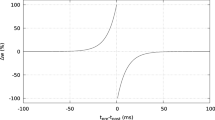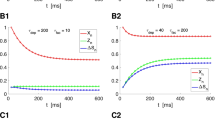Abstract
This work presents a model of minimal time-continuous target-cell specific use-dependent short-term synaptic plasticity (STP) observed in the pyramidal cells that can account for both short-term depression and facilitation. In general it provides a concise and portable description that is useful for predicting synaptic responses to more complex patterns of simulation, for studies relating to circuit dynamics and for equating dynamic properties across different synaptic pathways between or within preparations. This model allows computation of postsynaptic responses by either facilitation or depression in the synapse thus exhibiting characteristics of dynamic synapses as that found during short-term synaptic plasticity, for any arbitrary pre-synaptic spike train in the presence of realistic background synaptic noise. Thus it allows us to see specific effect of the spike train on a neuronal lattice both small-scale and large-scale, so as to reveal the short-term plastic behavior in neurons.
Access this chapter
Tax calculation will be finalised at checkout
Purchases are for personal use only
Preview
Unable to display preview. Download preview PDF.
Similar content being viewed by others
References
Tsodyks, M.V., Markram, H.: The neural code between neocortical pyramidal neurons depends on neurotransmitter release probability. Proc. Natl. Acad. Sci. USA 94(2), 719–723 (1997)
Zucker, R., Regehr, W.: Short-term synaptic plasticity. Annu. Rev. Physiol. 64, 355–405 (2002)
Kistler, W., van Hemmen, J.: Short-term synaptic plasticity and network behavior. Neural Computation 11, 1579–1594 (1999)
Varela, J., Sen, K., Gibson, J., Fost, J., Abbott, L., Nelson, S.: A quantitative description of short-term plasticity at excitatory synapses in layer 2/3 of rat primary visual cortex. J. Neurosci. 17, 7926–7940 (1997)
Tsodyks, M., Pawelzik, K., Markram, H.: Neural networks with dynamic synapses. Neural Computation 10, 821–835 (1998)
Tsodyks, M., Uziel, A., Markram, H.: Synchrony generation in recurrent networks with frequency-dependent synapses. J. Neurosci. 20 (2000)
Sengupta, B.: Modeling of short-term synaptic plasticity. Undergraduate Thesis (2004)
Dobrunz, L., Stevens, C.: Heterogeneity of release probability, facilitation and depletion at central synapses. Neuron 18, 995–1008 (1997)
Fuhrmann, G., Segev, I., Markram, H., Tsodyks, M.: Coding of temporal information by activity-dependent synapses. J. Neurophysiol. 87, 140–148 (2002)
Author information
Authors and Affiliations
Editor information
Editors and Affiliations
Rights and permissions
Copyright information
© 2005 Springer-Verlag Berlin Heidelberg
About this paper
Cite this paper
Sengupta, B. (2005). Modeling of Short-Term Synaptic Plasticity Using Dynamic Synapses. In: Wang, L., Chen, K., Ong, Y.S. (eds) Advances in Natural Computation. ICNC 2005. Lecture Notes in Computer Science, vol 3610. Springer, Berlin, Heidelberg. https://doi.org/10.1007/11539087_55
Download citation
DOI: https://doi.org/10.1007/11539087_55
Publisher Name: Springer, Berlin, Heidelberg
Print ISBN: 978-3-540-28323-2
Online ISBN: 978-3-540-31853-8
eBook Packages: Computer ScienceComputer Science (R0)




